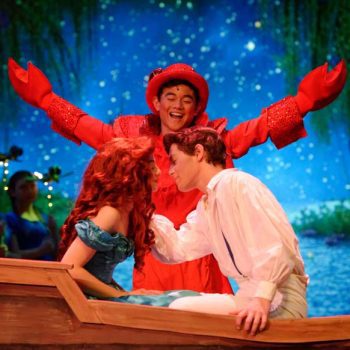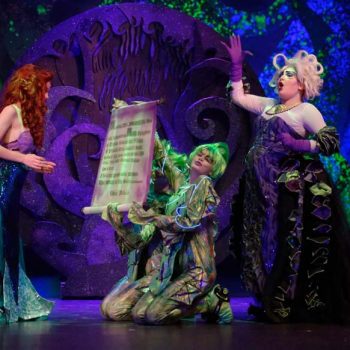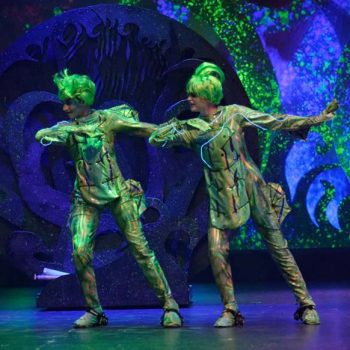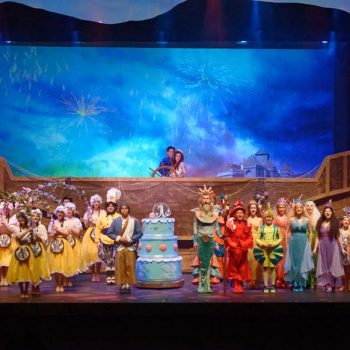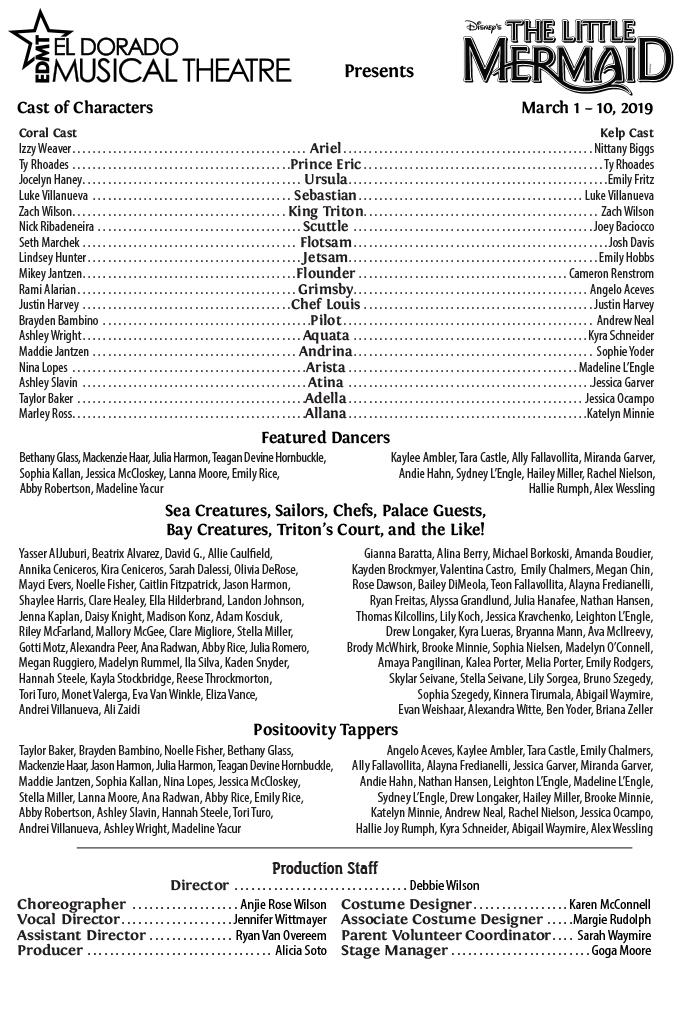Theatrical Review – Disney’s The Little Mermaid
By Dick Frantzreb
Maybe you’re thinking something like this: “The Little Mermaid? It’s just a children’s fairy tale, not very significant, and probably not worth my time.” Think again. For one thing, as the playbill proclaims, it’s “A Broadway Musical,” and it ran there for 735 performances. And for all that it’s fanciful, it’s an endearing love story, full of memorable music, great comedy, and moments that will touch your heart.
Furthermore, this is the El Dorado Musical Theatre (EDMT), with a long history of outstanding productions. And this particular show may stand at the pinnacle of their art. It’s a monumental effort full of dazzling effects and dazzling performances. On a “wow” scale of 1 to 10, it’s as close to 10 as anything I’ve seen. Read Debbie Wilson’s “A Note from the Director” in the attached playbill (see below), and you’ll see some of the challenges that EDMT faced ― and met ― in putting on this show.
The fundamental challenge was changing from the world below the sea to the world above. To a large extent this was accomplished by Zach Wilson’s eye-popping animated projections, each one arguably a work of art. Another way of distinguishing the two worlds was through “flying.” Often, when the characters were supposed to be in the water, they performed suspended above the stage. In fact, it seemed to me that there was even more flying in this show than there was in Peter Pan. And then there was the clever device of attaching rollers to the back of the actors’ shoes. Instead of walking around while under water, they leaned back on their rollers and glided as if swimming. Not only was it evocative of being underwater: it was appealingly graceful.
The distinction between the underwater world and the world on land was so effective that I have to give an example of the brilliant portrayal of the transition between them. From a storm-tossed ship, Prince Eric has fallen overboard, and we see him dangling 15 feet above the stage in front of an undersea projection. Ariel rises from the stage to save him, as the animated projection itself climbs from the depths. The two actors are lowered to the stage, where a stage-long bit of blue and white cloth, meant to represent the surf, has been set up. Prince Eric rolls underneath this cloth as if being washed up on shore. It was all so realistic that it drew a gasp from the audience. We were similarly impressed by the way that Ariel becomes human (with legs) ― while flying above the stage. Believe me, it wasn’t just the children who were entranced by moments like these.
With the caveat that EDMT productions are double-cast, and I only saw the Coral Cast on opening night, I have to comment on the performers I saw. Izzy Weaver was a perfect Ariel, with an openness and innocence that would draw one to her. Her acting was impressive, always in character, and it was a delight to hear her sing. When she sang “Part of Your World,” she was swinging around in the air above the stage, as if she were swimming in the water. To me it was amazing that she was able to keep her vocal quality and expressiveness while suspended. She even did a back-flip at one point. And when the song concluded, the audience roared its approval.
Fourteen-year-old Ty Rhoades was Prince Eric. A veteran of many EDMT shows, his acting and stage presence made him an effective leading man. His voice was clear and strong, and he and Izzy Weaver persuaded me that there really was chemistry between Ariel and Prince Eric.
The perfect EDMT show is the one in which everyone gets to be a star ― at least for a few minutes. For Ariel’s 6 sisters, it was in “She’s in Love” a doo-wop number with cute choreography and lyrics. That same number had a special moment for Mikey Jantzen as Flounder when he amazed us with both his dancing and a fantastic obbligato over the melody. “Les Poissons” was a scene that seemed to depart from the plot, but it was still great fun in showcasing the comic acting of Justin Harvey as Chef Louis. And Flotsam and Jetsam (Seth Marchek and Lindsey Hunter) were delightful villains, with good acting, movement, and singing.
Luke Villanueva was full of surprises as he played Sebastian the Crab, in his lobster-red suit with a matching top hat, and claws instead of hands. He fretted around the stage, constantly leaning forward and speaking in Sebastian’s Caribbean accent. His comic character was a delight to watch throughout the show. But his singing and spirited acting really stood out, first in “Under the Sea” and then later in “Kiss the Girl,” when he came out with a high note that was just amazing.
I think all of us in the audience were absolutely dazzled by the variety and creativity in the costumes, evoking a variety of sea creatures, real or imaginary. It was absolutely kaleidoscopic. You can see what I mean if you’ll check the cast photos at the end of the attached excerpt from the program.
But of the many over-the-top costumes, that of Ursula the Sea Witch may have been the most impressive. Her many legs suggested she was an octopus, and her wig was a hairdresser’s work of art. But beyond the inspired costume, Jocelyn Haney played this part to the hilt. She was deliciously evil, and her singing impressed me greatly. But whether singing or speaking, I was amazed at how completely she inhabited her part with gestures and intonation. And Jocelyn took it to the max in her hilarious performance of “Poor Unfortunate Souls,” with a character voice, acting, and comic timing that were just perfect.
I’ve been a fan of Nick Ribadeneira since I saw him in The Jungle Book. This time, as Scuttle the Seagull, Nick was the first to “fly” in this show. I’ve seen Nick put everything he has into the parts he plays, and here, while constantly flapping his “wings,” he sang and spoke in an outrageously raspy voice ― that may require some time to recover from!
There are so many highlights in EDMT shows, and something to look forward to are the big stage-packing numbers in which the whole cast comes out in their varied costumes, performs intricate routines with creatively choreographed dances, plus great solo and ensemble singing. There were several of these spectacles in this show. Each is like a three-ring circus, sometimes almost to the point of sensory overload, but great fun. During “Under the Sea,” I heard several “wows” around me, and in my notes I commented that it was “a masterpiece of staging, choreography, and costuming.” And all that was in addition to the excellent performance of that spirit-lifting song.
I have to add one more highlight. It was a wonderful bit of choreography that had the stage full of 24 tap-dancing seagulls, each with an evocative seagull costume, complete with orange boot covers ―and synchronized bird-like movements.
A lot of this show is about teen angst, something that an audience can recognize, regardless of one’s age. And it made the eventual reconciliation of father and daughter an especially sweet moment. I’m pretty sure I heard a sympathetic crying at this point from a child in the audience near me. Indeed, there were many emotional high points in what became for all of us a believable love story. And one couldn’t imagine a more “feel good” ending, as was reflected in the spontaneous cheers of the audience.
This was the kind of show that has you commenting to the person next to you ― someone you’ve never met before ― how what you just saw and heard was so great. What a pity that EDMT’s The Little Mermaid has only a 2-week run. Surely, the investment in time and money must have been unprecedented: for costumes, sets, props and projections ― forgetting about the work of preparing the actors. I’m no expert ― just an adoring fan ― but it seems to me that Debbie Wilson (Director), Angie Rose Wilson (Choreographer), Jennifer Wittmayer (Vocal Director), Karen McConnell (Costume Designer), Margie Rudolph (Associate Costume Designer), and Alicia Soto (Producer) ― have reached a new peak of excellence in local musical theatre.









